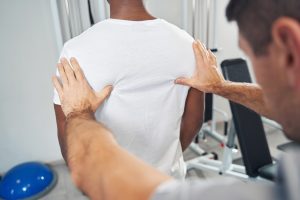Osteoarthritis is a common joint condition. It affects the vast majority of people across the world. In this piece of writing, I will highlight a specific type of OA: Osteoarthritis of the Knee.
Osteoarthritis of the knee, usually referred to as knee OA, is a joint degenerative disorder. It develops when the shielding cartilage that provides cushioning to the ends of your bones tears down periodically. When this cushioning wears and tears, it can cause pain, discomfort, stiffness, and decreased mobility in your knee joints.
Signs & Symptoms of Knee Osteoarthritis
Pain and discomfort: Knee OA characteristically begins with moderate pain that worsens over time, especially when performing activities like walking or climbing stairs.
Stiffness and inflexibility: Your knee may sometimes feel stiff, making it hard to bend or straighten your leg.
Swelling & inflammation: Inflammation usually causes knee swelling and makes it look bumpier and more prominent than usual.
Crepitus (cracking sounds): You may notice a cracking sound or gratin whenever you move your knee.
Restricted Range of Motion: OA can restrict your knee’s range of movement, making it challenging to do your everyday tasks.
Causes of Knee Osteoarthritis
Although the precise reason for knee OA isn’t always apparent, several factors can increase your risk:
Age: The possibility of knee OA increases when you age.
Obesity: Lifting extra weight puts greater pressure on your knee joints.
Injury: Preceding knee injuries and surgeries can lead to OA development.
Genetics: If OA runs in your family, your knees will be prone to pain.
Gender: As compared to men, women are more likely to undergo knee.
Diagnosis of Knee OA
For the identification of Knee OA, your doctor will begin with the following:
Review Symptoms: Discuss the signs and symptoms and your medical history with your doctor.
Physical Examination: The doctor will thoroughly examine the knee to check OA.
X-rays: X-rays are administered to figure out joint damage and cartilage loss.
Treatment Options
Pain Relief: Doctors can suggest over-the-counter pain relievers such as acetaminophen or nonsteroidal anti-inflammatory drugs (NSAIDs) to alleviate pain.
Physical Therapy: Here, your health professional will recommend some exercises that will strengthen muscles around your knee; by doing so, joint stability will be improved.
Lifestyle Changes: Avoid lifting heavy weights; by avoiding such activity, you can prevent knee pain
Assistive Gadgets: Devices like knee braces or canes promise to provide support.
Injections: Corticosteroid or hyaluronic acid injections can lessen pain and discomfort.
Surgery: In intense cases, surgical options, including knee replacement, may be considered.
How to Knee OA
Though there are few potential risks that you can control yet, you can take some safety measures to diminish your risk of developing knee OA:
Stay Active: Regular exercise helps maintain joint flexibility and strength.
Maintain a Healthy Weight: Shedding excess pounds can ease the stress on your knee joints.
Avoid Injury: Protect your knees during physical activities and sports.
Proper Footwear: Opt to wear supportive shoes to decrease strain on your knees.
Living With Knee OA
Although Knee OA is a chronic condition, you can live a fulfilling life with proper safety measures and management.
Key Points to Remember:
Medication: Taking the prescribed medications is a must. Whatever your healthcare provider prescribes, stick to it.
Exercise: You must pursue a tailored exercise program your physical therapist suggests.
Diet: A balanced diet is a key to sustaining your overall health.
Rest: Pay attention to your body and take rest when needed.
Support: spend quality time with your family and friends for emotional support.
Knee osteoarthritis is a common joint condition that can lead to inflammation, aches, and reduced mobility. Though there is no precise treatment, some practical ways exist to administer the symptoms and recover your quality of life. By understanding the signs and causes, getting proper medical advice, and making constructive lifestyle changes, you can manage your knee OA and continue to enjoy an active life.








